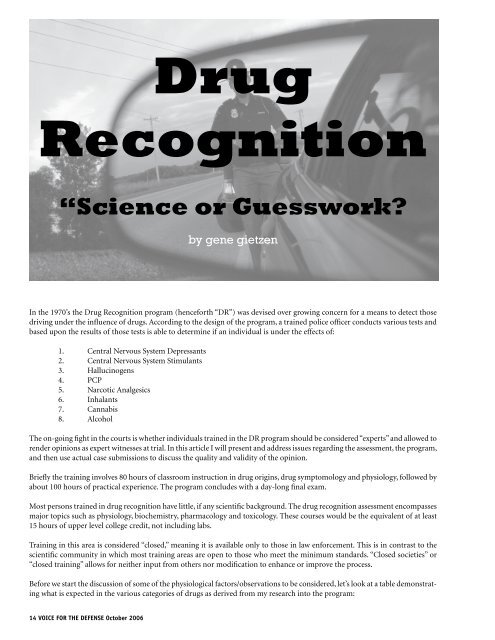Texas Criminal Defense Lawyers Association - Voice For The ...
Texas Criminal Defense Lawyers Association - Voice For The ...
Texas Criminal Defense Lawyers Association - Voice For The ...
Create successful ePaper yourself
Turn your PDF publications into a flip-book with our unique Google optimized e-Paper software.
Drug<br />
Recognition<br />
“Science or Guesswork?<br />
by gene gietzen<br />
In the 1970’s the Drug Recognition program (henceforth “DR”) was devised over growing concern for a means to detect those<br />
driving under the influence of drugs. According to the design of the program, a trained police officer conducts various tests and<br />
based upon the results of those tests is able to determine if an individual is under the effects of:<br />
1. Central Nervous System Depressants<br />
2. Central Nervous System Stimulants<br />
3. Hallucinogens<br />
4. PCP<br />
5. Narcotic Analgesics<br />
6. Inhalants<br />
7. Cannabis<br />
8. Alcohol<br />
<strong>The</strong> on-going fight in the courts is whether individuals trained in the DR program should be considered “experts” and allowed to<br />
render opinions as expert witnesses at trial. In this article I will present and address issues regarding the assessment, the program,<br />
and then use actual case submissions to discuss the quality and validity of the opinion.<br />
Briefly the training involves 80 hours of classroom instruction in drug origins, drug symptomology and physiology, followed by<br />
about 100 hours of practical experience. <strong>The</strong> program concludes with a day-long final exam.<br />
Most persons trained in drug recognition have little, if any scientific background. <strong>The</strong> drug recognition assessment encompasses<br />
major topics such as physiology, biochemistry, pharmacology and toxicology. <strong>The</strong>se courses would be the equivalent of at least<br />
15 hours of upper level college credit, not including labs.<br />
Training in this area is considered “closed,” meaning it is available only to those in law enforcement. This is in contrast to the<br />
scientific community in which most training areas are open to those who meet the minimum standards. “Closed societies” or<br />
“closed training” allows for neither input from others nor modification to enhance or improve the process.<br />
Before we start the discussion of some of the physiological factors/observations to be considered, let’s look at a table demonstrating<br />
what is expected in the various categories of drugs as derived from my research into the program:<br />
14 VOICE FOR THE DEFENSE October 2006

















